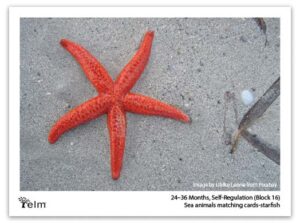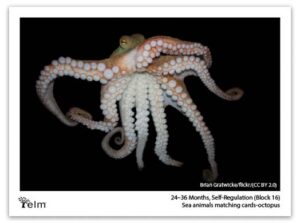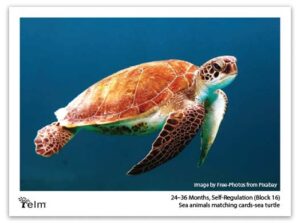Concentration
Toddlers help a caregiver pay attention to whether pictures of sea animals are the same or different in a picture-matching game.



Be Prepared: The picture cards show four different sea animals: starfish, octopus, shark, sea turtle (one animal per card). Three cards show the same animal (total: 12 cards). Put one card for each of the four animals face up in a row on a low table. Shuffle the remaining cards and put them in a small stack, face down, on a corner of the table.
[Invite 3–4 toddlers to join you at a table to help you play a matching game.]
 Here are some cards with pictures of animals that live in the sea. Let’s find out what animals are shown on the cards.
Here are some cards with pictures of animals that live in the sea. Let’s find out what animals are shown on the cards.
[Point to each picture card as you describe it.  Hold up the card, if necessary, to ensure each toddler sees it. Some toddlers may want to take a closer look by holding the card briefly.]
Hold up the card, if necessary, to ensure each toddler sees it. Some toddlers may want to take a closer look by holding the card briefly.]
 This card shows a picture of a starfish. A starfish has five arms. There are different colors of starfish. The starfish shown on our card is red.
This card shows a picture of a starfish. A starfish has five arms. There are different colors of starfish. The starfish shown on our card is red.
Here is a picture of an octopus. An octopus has more arms than the starfish. An octopus has eight arms! How many arms do we have?
[Put the starfish and octopus cards next to each other or hold them up next to each other. Point to your eyes and to your ears when you ask the third question.]

We are paying attention by looking. We are looking closely at how pictures of things are the same or different.
[Show and discuss pictures of the remaining two animals, one at a time. Emphasize how the animals are different from others.]
We looked at pictures of four different animals that live in the sea. We paid attention to how the pictures were different.
I have some more pictures of the animals. Let’s look at each picture and decide whether it matches one of the pictures on our table. Pictures that match show the same animal.
[Place the row of cards, each facing up, toward the top of the table. Two more identical cards will be placed under each.
Place the small stack of remaining cards, facing down, in a more prominent place on the table or in your hand. Take one card from the stack of cards and hold it next to the picture of a different animal. Explain that the two pictures do not match. Example: “This is a starfish. This is a sea turtle. These pictures do not match. They are different animals.”
Invite toddlers to point to the picture on the table that matches the picture in your hand. Emphasize that we are paying attention to the pictures when we decide whether they are the same or different. Example: “We are looking closely at each picture. We are paying attention to what we see in the pictures.”
Turn over each remaining card, one at a time, and invite toddlers to tell which of the four cards on the table it matches. Repeat the process used with the first card, if appropriate.
Continue until all 12 cards are on the table if toddler interest and time permit.]
You helped me play a game of matching cards that show pictures of animals that live in the sea. We looked at each picture and found another picture it matched. Things that match are the same. We paid attention by looking at each picture.
Concentration
Toddlers practice paying attention to pictures of sea animals in a picture-comparison game.



Invite two toddlers to join you at a table to play a game with picture cards. Explain that the cards show pictures of animals that live in the sea. One at a time show each picture, say the name of the animal, and draw attention to some of its characteristics, such as the many arms of an octopus and color of the starfish.
 Explain that in our game, we want to look at two pictures and figure out if the animals shown in the pictures are the same or different. We can pay attention to each picture by looking closely.
Explain that in our game, we want to look at two pictures and figure out if the animals shown in the pictures are the same or different. We can pay attention to each picture by looking closely.
 Display two cards that show the same sea animal and two cards that show different sea animals. Point to each set of cards and ask the toddlers which set of cards show the same animal and which set of cards show different animals. Encourage toddlers to tell why two pictures are the same and why two pictures are different. Repeat and expand on their explanations. Example: “Jaxon said the pictures are different because they show different animals. One picture shows a starfish. One picture shows an octopus.”
Display two cards that show the same sea animal and two cards that show different sea animals. Point to each set of cards and ask the toddlers which set of cards show the same animal and which set of cards show different animals. Encourage toddlers to tell why two pictures are the same and why two pictures are different. Repeat and expand on their explanations. Example: “Jaxon said the pictures are different because they show different animals. One picture shows a starfish. One picture shows an octopus.”
 Shuffle all 12 cards and place the small stack of cards face down in front of the toddlers. Invite each toddler to pick up one card from the stack. Encourage the toddlers to look at the two cards and tell whether the pictures are the same or
Shuffle all 12 cards and place the small stack of cards face down in front of the toddlers. Invite each toddler to pick up one card from the stack. Encourage the toddlers to look at the two cards and tell whether the pictures are the same or  different. Invite the toddlers to explain how the pictures are the same or different. Repeat and expand on their explanation. Then put the two cards next to each other, facing up, elsewhere on the table.
different. Invite the toddlers to explain how the pictures are the same or different. Repeat and expand on their explanation. Then put the two cards next to each other, facing up, elsewhere on the table.
Continue this process until there are no cards remaining in the small stack. There will be six sets of two cards facing up on the table. Invite the toddlers to take turns looking at each set of two cards and tell whether the pictures are the same or different. Provide turn-taking guidance for this review. Example: “Okay, now it is Jaxon’s turn to tell whether the two pictures are the same or different.”
Conclude the activity by briefly describing what happened. Emphasize the importance of looking closely at each picture. Looking is one way we pay attention.
The activity options extend the Block 15 puzzle activities that emphasize the importance of concentration in games and related tasks. The two activity options also complement the task of matching real and pictured items offered in the current block (Cognitive). The use of the same material (pictures) and focus on concentration skills provide a different emphasis in the current activity plan than offered in the Cognitive activity plan of matching pictures and real things. Option 2 intentionally emphasizes the concepts of same and different in an effort to promote a close look at each picture.
One of the challenges of facilitating an informal gathering is to notice how each child is responding to the activity. A related challenge is to ensure that each child has an opportunity to participate. It is easy for an activity to be dominated by a child who promptly and eagerly identifies the same picture on the table (Option 1) or says whether two cards are the same or different (Option 2). The review of paired cards at the end of Option 2 provides a small opportunity for each child to be an active contributor.
Extra support
Enrichment
Materials needed: water table; toy sea animals—2 of each type; other sea life, such as (artificial) plants, a small amount of sand, large shells
Optional reading: Pop-up Peekaboo: Under the Sea by DK Publishing
Place the toy sea animals and other sea-life items in the sensory table with 1–2 inches of warm water. Invite several toddlers to play with the animals in the pretend sea. Encourage toddlers to find sea animals that are the same. They could place them together in different parts of the pretend sea. Also, encourage toddlers to put together pairs of animals that are different.
Materials needed: Go Fish card game
In addition to offering Options 1 and 2 to toddlers, engage preschool-age and older children to play a game of Go Fish.